If you are interested in building wooden houses If you look outside for information, you'll see that the most common material is CLT (Cross Laminated Timber) - considered by many to be the material of the future. Almost unknown to us, it has been used for some time in European countries to build 7 or 10-storey houses. Used to build passive cell, is an essential contribution to reducing energy costs. We'll be talking more about this material, the pros and cons of using it, tall buildings made entirely of wood and how you can build like this in Romania.
What is CLT
It is a building material made by gluing several layers of wood perpendicular to each other. The resulting panel is similar to a tackle, with the difference that instead of veneer sheets there are timber panels. As with plywood, the number of layers is odd. Depending on the desired final properties, there may be 3,5, 7 or 9 layers of wood.
These panels are made in a similar way to laminated beams (glulam) except that in glulam the layers of wood have parallel grain. It is, however, the same way of lengthening wooden elements by finger-jointing, and very moisture-resistant adhesives are used.
The material first appeared in Switzerland in the 70s, but industrial manufacturing began in Austria in the 90s. It wasn't very successful at first because of the prejudices associated with building with wood: construction with low resistance over time, to damp, fire or insect attack. Growing environmental concerns and the trend towards phasing out carbon-intensive technologies have brought the material back to the attention of builders who are gradually discovering its potential and advantages in terms of quality, strength, durability and cost-effectiveness.
If you're thinking of more serious documentation, you should know that you can also find it under other names: KLH (mostly found in Austria and Germany), cross-lam, X-lam or jumpo plywood.

How CLT panels are made
Making CLT and building with it is different from conventional building materials. The material is not manufactured and sent to building material warehouses where we take it to build the house. The process starts with the design of the house and all the necessary calculations of strength, splitting, sizing, etc. As with prefabricated frame houses, there must first be the design.
Once the project is finalized it goes to the factory. Here the construction of each individual wall according to the design begins. Everything is computerized and the dimensions are passed on to robots, which place the pieces of timber and glue them together. Once the glue is applied, the layers of wood are transported by cranes and laid on top of each other perpendicularly. The panel is then squeezed to eliminate voids and put into the press which hardens the adhesive using high-frequency currents (CIF).
After gluing, the panels are sanded, shaped, and then all the necessary work is done: the window and door openings are cut, spaces or paths are milled for various installations, etc. The walls of the house become huge Lego pieces that are packed and transported to be assembled on the foundation built in the meantime.
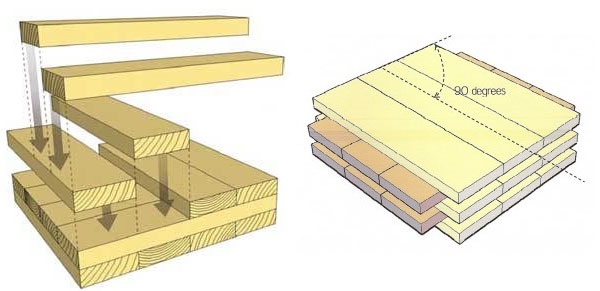
Why build with CLT. The main advantages of using the material
The big advantage is that the material is much lighter than a similar brick or concrete wall. The construction itself will be much easier, which means that the foundations don't have to be built like a concrete or brick house, cutting costs.
Very high strength and stability. The perpendicular laying of the layers and the elimination of defects in the wood before gluing give the panel these qualities. The possibility of obtaining the walls with a different number of layers makes it possible to obtain thicker walls - the load-bearing walls - or thinner walls - the partition walls. The very high load-bearing capacity of load-bearing walls allows for the elimination of load-bearing studs and the creation of large open spaces, as well as greater design flexibility.
Reduced construction time is another advantage. As the walls are made entirely in the factory, only assembly is done on site. It eliminates reaction time - curing the concrete - or supply time. Andrew Waugh, the architect who built the tallest CLT building in the world at the time - Dalton Works in east London - said construction time had been cut six times and material deliveries had fallen from 800, if the building had been made of concrete, to 111.
Capacity of thermal insulation very good. It is well known that wood is a very good insulating material. In addition, it is naturally warm, keeping a very pleasant atmosphere inside. Using such walls, determining and solving the points where heat can be lost, results in a passive house whose energy costs are almost non-existent.
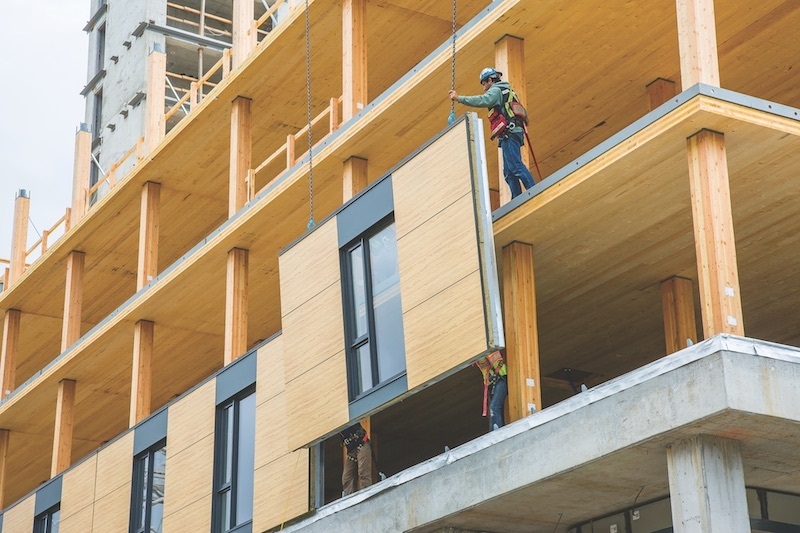
As with any material, there are weaknesses
As there is no perfect material and when using these panels there are some disadvantages. One would be the thickness of the flooring. For the same strength CLT flooring will be thicker than concrete. In addition, sound insulation is lower and has to be improved with special materials.
Limiting the uninterrupted length of the panel is another disadvantage. The maximum dimensions at which panels can now be achieved are 16 m long and 4-5 m wide. To make taller constructions it is necessary to match these elements very well. The existence of a 7-storey building in Norway since 2012 and a 10-storey building in London (since 2015) shows that this is a drawback that can be overcome. What's more, the worldwide take-up of this type of construction shows that even the most skeptical of builders have overcome their misgivings about this innovative building material.
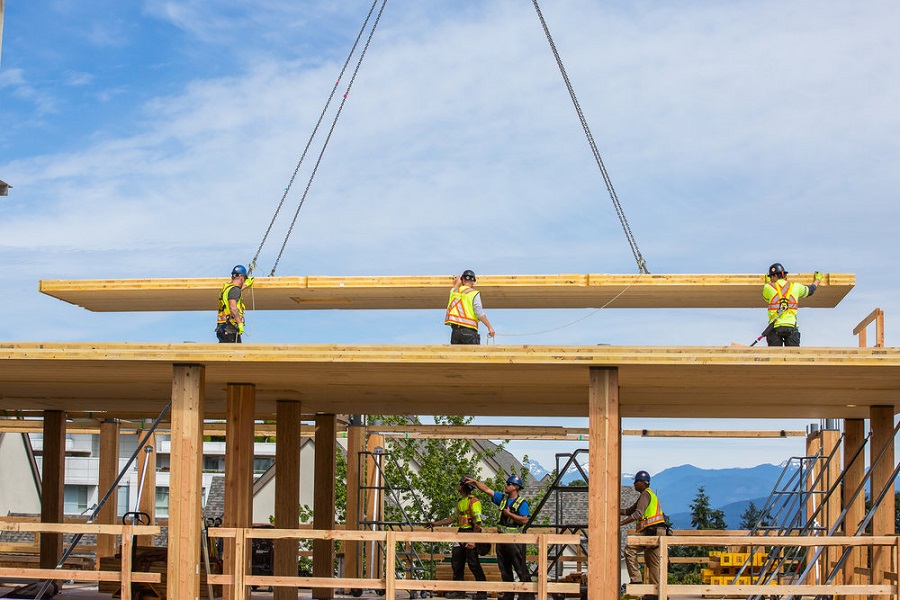
Fire resistance
I have chosen to deal separately with the fire resistance of CLT panels because I am convinced that by now there have been many who have wondered continuously what happens if a fire breaks out. The material is very resistant to burning and, like glulam beams, retains its load-bearing capacity in the event of a fire. The fire only advances through the first layer of wood and stops in the adhesive layer. The formed charcoal layer acts as protection and the wood does not lose its strength.
Unlike wood, iron (including that in reinforced concrete) loses its strength at over 700 ºC and no longer has the strength to support the construction, causing it to collapse. So, not only is there no greater danger with CLT construction, it is actually stronger than concrete.
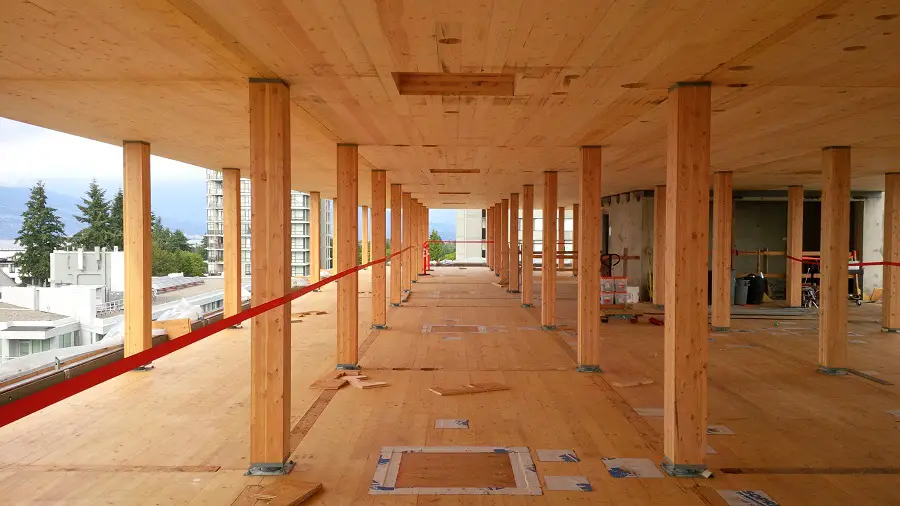
CLT construction in Romania
I said at the beginning that in Romania the material is little known. However, there are a few such constructions. The one that has drawn most attention to passive houses and the building materials for them is George Buhnici, the former ProTV presenter with a passion for IT. He built his home using the new A wave of architects and builders, young people with a passion for modern products and technologies as well as environmental protection.

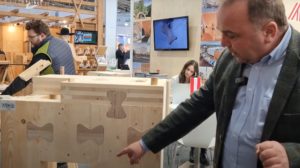


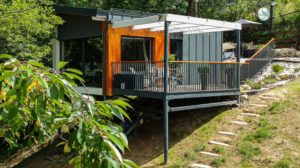


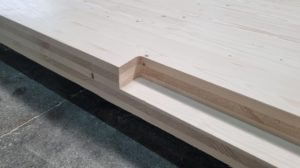
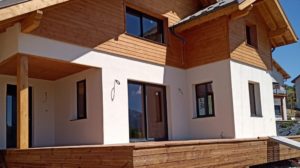
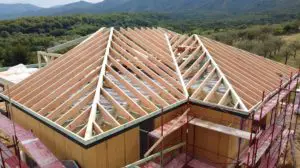



Hello, the name in German (Austria, Germany) is BBS, an acronym. KLH is the name of a manufacturer only.
It is not true that the thickness of a slab is greater than that of concrete for the same span, and even the opposite.
Thank you.
Hi. A search on BBS resulted in images of aluminum wheels. What is the unabbreviated name?
For the renovation of an attic where the concrete slab (floor) is thin and in "waves", can this material be used?
Does an article on costs exist?
Thank you!
Hello!
CLT is a heavy material for building house walls. It would be a very serious demand for concrete slab and the house in general. In my opinion the most suitable would be OSB. A wooden frame on the concrete slab, which you fill with insulation and over which you put the OSB boards would solve the problem of bumps, but also of thermal and sound insulation between the attic and the lower level.
All the best!
https://revistadinlemn.ro/2017/10/19/osb-ce-este-si-la-ce-se-foloseste/
Don't forget to subscribe to the printed Wood Magazine! For only 58 lei/year you can find out news in the field, discover craft ideas or trade secrets. We remind you that the content in the printed magazine is different from the one on the website. Details in the link below.
Thank you!https://revistadinlemn.ro/product/abonament-revista-din-lemn/
Mrs. Mihaela! Your answer is incorrect.CLT weighs 500kg per cubic metre and reinforced concrete between 2000 and 2500 (depending on the concrete iron). Of course a check of concrete structures is needed to understand what the CLT loads are, but that does not mean it is not possible. In Europe and other countries in the world this system is allowed by the authorities faster than in others. I could document you at any time that you are wrong. Have a nice day
Good evening!
Thanks for the clarification. The purpose of the article is to present one of the new wood building materials considered a material of the future. Any clarification or addition on the qualities of the material is very welcome.
All the best!
Where can I buy CLT in Romania...I really like the idea of building a house and I want to know the costs...next week I'm starting the foundation and I want to know what and how to do it!
Hello!
I've seen comments saying that there are also Romanian CLT manufacturers. I know that most CLT wall builders work with Austrian or German manufacturers. The CLT walls are brought from there to size, according to design.
CLT made in Austria found at Holver.
All the best!
I also need to know some CLT houses factories in Romania, can you tell me some names ? thanks
Hello!
What is the cost of finishing the walls (sanding, sanding, priming and varnishing) per square metre?
Thank you.